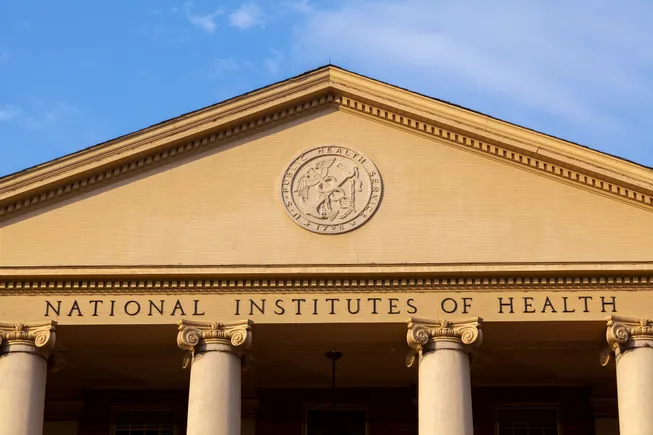The biotechnology sector’s foundations rest on basic scientific research. Early experiments done in academic laboratories often yield the discoveries that venture investors later form drug startups around.
Investors and industry experts are concerned that system is under threat in the U.S., where the Trump administration has roiled the scientific community with actions disrupting funding provided by the National Institutes of Health to research institutes around the country. The administration has also imposed large-scale layoffs at the NIH and other health agencies like the Food and Drug Administration.
One of the most notable changes is a new NIH policy that would limit its funding of “indirect” costs to 15% of new federal grants, substantially lower than what it typically provides now. While a federal judge on Friday extended a temporary pause to the policy in response to legal challenges from 22 attorneys general, some in the biotech industry see the clamp down on costs as risking slower research progress at a time when the U.S. is seeking to maintain its position as a life sciences leader.
“Scientific, long-term drug development requires government support of basic science,” said Chris Bardon, co-managing partner at investment firm MPM BioImpact. “That’s an absolute requirement. Nobody else can step in to fill that void if the federal government steps out.”
Grant funding handed out by the NIH helps pay recipients’ “direct” and “indirect” costs for running experiments and conducting research. The former covers expenses, such as salaries and lab supplies, that are directly associated with a research project and accounts for the bulk of NIH grant funding.
Indirect costs are the charges that support the infrastructure surrounding these experiments, from utility bills to payments for administrative workers. Those expenses are a big chunk of NIH funding: An estimated $9 billion of the $32 billion in NIH grants issued in the 2024 fiscal year went toward those costs, according to an analysis of federal data by The New York Times.
The rate of indirect costs reimbursed by NIH can vary from one university to another. According to the NIH, the average rate reported by the agency has been about 27% to 28% of the grant, but many organizations get more.
By capping that rate at 15%, the agency says it would save about $4 billion a year. In supplemental guidance, the agency noted that most private foundations cover indirect costs at “substantially lower” rates than the federal government, and universities accept grants from them nonetheless. It is “vital to ensure that as many funds as possible go towards direct scientific research costs rather than administrative overhead,” NIH officials wrote in the guidance.
Trimming back NIH funding support could forestall a wide variety of research as universities weigh whether they can afford to green light new projects with less money. That, in turn, could eventually hinder the creation of biotech startups in the future, or affect which get launched when.
Some biotech investors and entrepreneurs say they are already noticing effects. One example is Lux Capital, a firm that’s funded notable university spinouts such as Aera Therapeutics, Eikon Therapeutics and eGenesis. David Yang, one of the firm’s principals, said the news has prompted some academic institutions to reach out and ask for funding to cover their overhead costs.
Michelle Hoffmann, executive director of the Chicago Biomedical Consortium — a government and philanthropy-funded alliance between nine of the area’s top research institutions — says she hasn’t heard from the NIH in more than a month, hampering her planning to build up the area’s biotech capabilities.
“We are incredibly worried that we’re not going to get enough projects through our process to be building new, small companies,” Hoffmann said. Among universities, “there’s just a lot of fear and uncertainty” and “tightening belts,” she added.
The impact likely won’t be “evenly distributed” either, hitting smaller schools harder than ones with much larger endowments, noted Lindy Fishburne, a managing partner at Breakout Ventures, a firm specializing in seed and Series A rounds.
Bardon, of MPM, warned the pullback could threaten the next generation of young researchers. Already, reporting by Stat has indicated certain universities may cut back admissions for the post-doctoral researchers and graduate students who typically go on to become career scientists.
Young investigators “are some of the most productive people that we’re cutting,” she said. “Cutting-edge science tends to come out of people’s laboratories when they’re 30 to 50 years old.”
“It’s not that we won’t get there, but we just have less time, money and people working on it,” Bardon said.
She and others added that, while it’s worthwhile to scrutinize administrative costs, the Trump administration’s plan goes too far and ignores long-term impacts.
It’s like “doing this with a hammer instead of scalpel,” Fishburne said, adding that there will be a “multi-year lag” before the effects are “felt broadly in the market.”
Investors are also concerned the administration’s blows to scientific research may put the U.S. biotechnology sector at a disadvantage while global competition, particularly from China, grows.
A letter authored by Peter Kolchinsky, co-founder of RA Capital Management, Luke Evnin of the Scleroderma Research Foundation and Peter Rubin of No Patient Left Behind, called the administration’s actions an “assault on the foundation of biomedical and technological progress.”
The work funded by the NIH “fuels an industry that has emerged as a strategic national asset and critical pillar of the U.S. economy,” the authors wrote. The letter has been co-signed by hundreds of investors, biotech executives, scientists and patient advocates.
Uncertainty surrounding NIH funding could motivate other parts of the biotech ecosystem to try filling the gap.
A startup accelerator called Altitude Lab, backed by biotech Recursion Pharmaceuticals, announced last week a new fund to give pre-seed grants to researchers and startups disrupted by the funding cuts. Executive director Chandana Haque referred, in a statement, to the fund as Altitude doing its “small part to help secure the future of biotech innovation in America.”
Much more would be needed if the cap to indirect costs is put in place permanently. In a recent op-ed, Recursion CEO Chris Gibson called on industry peers to “step up to help keep the money going for the next generation of innovators.”
Venture firms could respond by changing how they invest. But Yang, of Lux Capital, notes that stepping in so early could lead companies to be spun out earlier than they should. Sometimes science “just needs more time” before venture capitalists should come in, he said, and “it’s better to do that in the academic setting.”
Another alternative may be large nonprofit groups like the Chan-Zuckerberg Initiative and the Bill & Melinda Gates Foundation, or disease-focused foundations. Though the NIH is the world’s largest funder of biomedical research, they and others also help fund the work that gets done before venture firms come aboard. (Neither have made announcements regarding the cuts so far.)
“There are billions of tax-advantaged dollars that are sitting in the endowments of private foundations around the country, and the mission and goals those philanthropy foundations say they care about might need to get activated to fill gaps if we fundamentally have a smaller government going forward,” Fishburne said.
Without that help, “how are you going to get the next generation of therapies?” said Hoffmann. “There’s no biotech without venture, but there’s also no biotech without academic discovery.”








